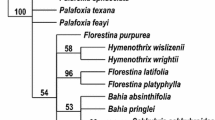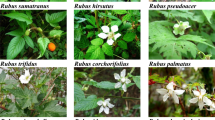Abstract
The genus Jatropha (Euphorbiaceae) contains species that are of significant economic and ornamental value. However, Jatropha breeding material is rather limited due to incomplete information regarding phylogenetic relationships among germplasm resources. Phylogenetic analyses were performed based on the internal transcribed spacer of nuclear ribosomal DNA (nrDNA ITS), two chloroplast regions (trnL-F and rbcL), and the combined (ITS+trnL-F+rbcL) dataset among twenty-five specimens representing six key Jatropha species. Phylogenetic relationships of Jatropha were well resolved between subgenus Curcas and subgenus Jatropha, and demonstrated the intermediate position of section Polymorphae among sections of both subgenera. Jatropha curcas and J. integerrima demonstrated a close phylogenetic relationship. The molecular data agreed with the morphological classification that recognized J. multifida and J. podagrica in sec. Peltatae. The distinct intraspecific divergence that occurred in J. curcas could be attributed to restricted gene flow caused by geographical isolation and different ecological conditions. Phylograms produced with trnL-F and rbcL sequence data suggested slow rates of sequence divergence among Jatropha spp., while the ITS gene tree had good resolution suggesting high genetic variation of ITS among Jatropha species.




Similar content being viewed by others
References
Bandelt HJ, Forster P, Röhl A (1999) Median-joining networks for inferring intraspecific phylogenies. Mol Biol Evol 16:37–48
Banerji R, Chowdhury A, Misra G, Sudarsanan G, Verma S, Srivastava G (1985) Jatropha seed oils for energy. Biomass 8:277–282
Basha S, Sujatha M (2009) Genetic analysis of Jatropha species and interspecific hybrids of Jatropha curcas using nuclear and organelle specific markers. Euphytica 168:197–214
Basha S, Francis G, Makkar H, Becker K, Sujatha M (2009) A comparative study of biochemical traits and molecular markers for assessment of genetic relationships between Jatropha curcas L. germplasm from different countries. Plant Sci 176:812–823
Dehgan B (1982) Comparative anatomy of the petiole and infrageneric relationships in Jatropha (Euphorbiaceae). Am J Bot 69:1283–1295
Dehgan B (1984) Phylogenetic significance of interspecific hybridization in Jatropha (Euphorbiaceae). Syst Bot 9:467–478
Dehgan B, Schutzman B (1994) Contributions toward a monograph of neotropical Jatropha: phenetic and phylogenetic analyses. Ann Mo Bot Gard 81:349–367
Dehgan B, Webster GL (1979) Morphology and infrageneric relationships of the genus Jatropha (Euphorbiaceae), vol 74. University of California Press, California
Dhillon R, Hooda M, Jattan M, Chawla V, Bhardwaj M, Goyal S (2009) Development and molecular characterization of interspecific hybrids of Jatropha curcas× J. integerrima. Indian J Biotechnol 8:384–390
Edrisi SA, Dubey RK, Tripathi V, Bakshi M, Srivastava P, Jamil S, Singh H, Singh N, Abhilash P (2015) Jatropha curcas L.: a crucified plant waiting for resurgence. Renew Sustain Energy Rev 41:855–862
Farris JS, Källersjö M, Kluge AG, Bult C (1994) Testing significance of incongruence. Cladistics 10:315–319
Fay MF, Swensen SM, Chase MW (1997) Taxonomic affinities of Medusagyne oppositifolia (Medusagynaceae). Kew Bull 52:111–120
Fu YX, Li WH (1993) Statistical tests of neutrality of mutations. Genetics 133:693–709
Heller J (1996) Physic nut. Jatropha curcas L. Promoting the conservation and use of underutilized and neglected crops.1. PhD Thesis, Institute of Plant Genetic and Crop Plant Research, Gatersleben, and International Plant Genetic Resource Institute, Rome
Hemming C, Radcliffe-Smith A (1987) A revision of the Somali species of Jatropha (Euphorbiaceae). Kew Bull 42:103–122
King AJ, He W, Cuevas JA, Freudenberger M, Ramiaramanana D, Graham IA (2009) Potential of Jatropha curcas as a source of renewable oil and animal feed. J Exp Bot 60:2897–2905
Kumar RS, Parthiban K, Rao MG (2009) Molecular characterization of Jatropha genetic resources through inter-simple sequence repeat (ISSR) markers. Mol Biol Rep 36:1951–1956
Mason-Gamer RJ, Orme NL, Anderson CM (2002) Phylogenetic analysis of North American Elymus and the monogenomic Triticeae (Poaceae) using three chloroplast DNA data sets. Genome 45:991–1002
Nei M, Li WH (1979) Mathematical model for studying genetic variation in terms of restriction endonucleases. Proc Natl Acad Sci 76:5269–5273
Nylander J (2004) MrModeltest v2.2. Program distributed by the author. Evolutionary Biology Centre, Uppsala University, Uppsala
Olowokudejo J (1993) Comparative epidermal morphology of West African species of Jatropha L. (Euphorbiaceae). Bot J Linn Soc 111:139–154
Pamidimarri DS, Reddy MP (2014) Phylogeography and molecular diversity analysis of Jatropha curcas L. and the dispersal route revealed by RAPD, AFLP and nrDNA-ITS analysis. Mol Biol Rep 41:3225–3234
Pamidimarri DS, Chattopadhyay B, Reddy MP (2009) Genetic divergence and phylogenetic analysis of genus Jatropha based on nuclear ribosomal DNA ITS sequence. Mol Biol Rep 36:1929–1935
Parthiban K, Kumar RS, Thiyagarajan P, Subbulakshmi V, Vennila S, Rao MG (2009) Hybrid progenies in Jatropha-a new development. Curr Sci 96:815–823
Ram SG, Parthiban K, Kumar RS, Thiruvengadam V, Paramathma M (2008) Genetic diversity among Jatropha species as revealed by RAPD markers. Genet Resour Crop Evol 55:803–809
Reddy K, Swamy N, Bahadur B (1987) Cross-incompatibility between Ricinus and Jatropha. Plant Cell Incompat Newslett 19:60–65
Ronquist F, Huelsenbeck JP (2003) MrBayes 3: Bayesian phylogenetic inference under mixed models. Bioinformatics 19:1572–1574
Rozas J, Sánchez-DelBarrio JC, Messeguer X, Rozas R (2003) DnaSP, DNA polymorphism analyses by the coalescent and other methods. Bioinformatics 19:2496–2497
Sudheer PD, Mastan SG, Rahman H, Prakash CR, Singh S, Reddy MP (2011) Cross species amplification ability of novel microsatellites isolated from Jatropha curcas and genetic relationship with sister taxa. Mol Biol Rep 38:1383–1388
Sujatha M (1996) Genetic and tissue culture studies in castor (Ricinus communis L.) and related genera. Ph.D. thesis, Osmania University, Hyderabad
Sujatha M (2006) Genetic improvement of Jatropha curcas L. possibilities and prospects. Indian J Agrofor 8:58–65
Sujatha M, Prabakaran A (2003) New ornamental Jatropha hybrids through interspecific hybridization. Genet Resour Crop Evol 50:75–82
Sujatha M, Bahadur B, Reddy TP (2013) Interspecific hybridization in the genus Jatropha. In: Bahadur B, Sujatha M, Carels N (eds) Jatropha, challenges for a new energy crop, vol 2. Springer, New York, pp 423–443
Swofford DL (2002) PAUP*: phylogenetic analysis using parsimony, Version 4.0b10. Sinauer Associates, Sunderland
Tajima F (1989) Statistical method for testing the neutral mutation hypothesis by DNA polymorphism. Genetics 123:585–595
Tamura K, Stecher G, Peterson D, Filipski A, Kumar S (2013) MEGA6: molecular evolutionary genetics analysis version 6.0. Mol Biol Evol 30:2725–2729
Tanya P, Taeprayoon P, Hadkam Y, Srinives P (2011) Genetic diversity among Jatropha and Jatropha-related species based on ISSR markers. Plant Mol Biol Report 29:252–264
Thompson JD, Gibson T, Higgins DG (2002) Multiple sequence alignment using ClustalW and ClustalX. Curr Protoc Bioinformatics, Chapter 2: Unit 2.3
Tokuoka T, Tobe H (2006) Phylogenetic analyses of Malpighiales using plastid and nuclear DNA sequences, with particular reference to the embryology of Euphorbiaceae sens. str. J Plant Res 119:599–616
Watterson G (1975) On the number of segregating sites in genetical models without recombination. Theor Popul Biol 7:256–276
White TJ, Bruns T, Lee S, Taylor J (1990) Amplification and direct sequencing of fungal ribosomal RNA genes for phylogenetics. PCR Protoc 18:315–322
Ye M, Li C, Francis G, Makkar HP (2009) Current situation and prospects of Jatropha curcas as a multipurpose tree in China. Agrofor Syst 76:487–497
Zhang Z, Liu B, Tang L, Chen F (2011) Genetic diversity and genetic relationship of Jatropha curcas between China and Southeast Asian revealed by amplified fragment length polymorphisms. Afr J Biotechnol 10:2825–2832
Acknowledgments
The research was partially supported by grants from the National “12th Five-Year” Science and Technology Support project of China (No. 2011BAD22B08).We thankfully acknowledge the Tropical Eco-agriculture Institute, Yunnan Academy of Agricultural Sciences and South China Botanical Garden, Chinese Academy of Sciences for kindly providing the plant materials.
Author information
Authors and Affiliations
Corresponding author
Ethics declarations
Conflict of interest
The authors declare that they have no conflict of interest.
Rights and permissions
About this article
Cite this article
Guo, Gy., Wang, Sh., Xu, Y. et al. Molecular phylogenetic analysis of key Jatropha species inferred from nrDNA ITS and chloroplast (trnL-F and rbcL) sequences. Genes Genom 38, 557–566 (2016). https://doi.org/10.1007/s13258-016-0406-6
Received:
Accepted:
Published:
Issue Date:
DOI: https://doi.org/10.1007/s13258-016-0406-6




